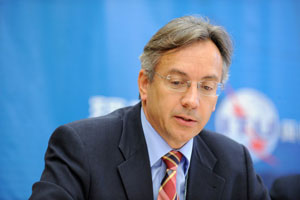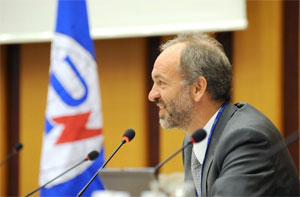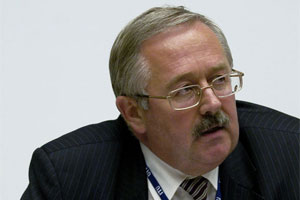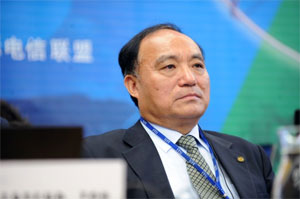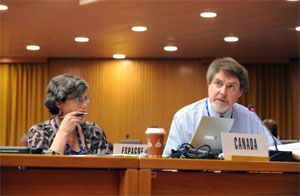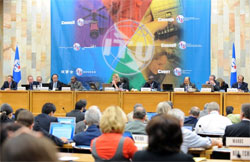|
Geneva, 27 October 2009 |
Not an official record |
N°6 |
|||||
| « Previous | |||||||
|
Four-year operational plan for the Radiocommunication Sector 2010-2013 (Document 13)
The document, introduced by Fabio Leite, Deputy to the Director of the Radiocommunication Bureau (BR), presents the highlights and key elements of the plan for the Radiocommunication Sector (ITU-R). It places emphasis on the outputs of the Sector and on BR’s activities to carry them out, as well as BR’s involvement in inter-sectoral outputs. Also included in the draft plan is information on linkage with ITU’s draft Strategic and Financial Plans, and the key performance indicators (KPI).
The five high-priority outputs for ITU-R have been identified (in no particular order of priority) as: world and regional radiocommunication conferences; processing of Space and terrestrial notices; ITU-R study groups; ITU-R publications, and assistance to members. Several councillors thanked BR for a clear and comprehensive report. The Republic of Korea also singled out for praise the establishment of a website where study groups can share documents and which is a big help to these groups in dealing with a “huge workload”. Saudi Arabia suggested that WRC Conference Preparatory Meetings should be listed under the Sector’s “Objective 1” on coordination among Member States, and that there should be reference to world seminars on radiocommunications — not just regional ones. Mr Leite said these points would be raised at the Radiocommunication Advisory Group (RAG) in preparing the next version of the draft plan. In response to a query from the United States, Mr Leite said there is no longer any backlog in satellite network filings, and that updated software to process notices on terrestrial services (to cover changes decided by WRC-07) has been almost entirely implemented. BR Director Valery Timofeev thanked Council for its comments, which he promised would be noted. He also gave his warm thanks to everyone in the BR team. The Council approved the draft Operational Plan for ITU-R for
2010-2013 and adopted the Resolution contained in the Annex to Document
13. Four-year operational plan for the Telecommunication Standardization Sector 2010-2013 (Document 14)
Reinhard Scholl introduced Document 14, which lists (in no special order) the six high-priority outputs for ITU-T that are identified in the operational plan: World Telecommunication Standardization Assembly; Telecommunication Standardization Advisory Group; ITU-T study groups; workshops; ITU-T publications; and promotion. A chart on page 5 shows the link between ITU-T outputs, objectives, missions and activities.
In order to deal with the challenging work programme, TSB is being reorganized into three sections: a Study Group Department, a Telecommunication Standardization Policy Department and a Services Department. A new WTSA Programmes Division under the Telecommunication Standardization Policy Department will have responsibility for many of the tasks given to TSB by WTSA-08. Several councillors expressed their thanks for the report. The United States asked about the principles behind the restructuring of TSB. In response, TSB Director Malcolm Johnson referred to details in Document 32, which is to be discussed by the Standing Committee on Administration and Management (ADM). Mr Johnson also said TSB is fully aware of a point raised by the Russian Federation, which had stressed the need for synergy and the avoidance of overlapping resources when ITU-T collaborates with other Sectors. Mali asked about “the state of play” with regard to ITU-T’s relationship with other standards-making bodies. Mr Johnson explained that, worldwide, there are some 300-500 such bodies in the field of ICT. “Maintaining ITU-T’s pre-eminence is a challenge,” he said; “we try to cooperate as much as possible, but it is a competitive environment”. A new high-level group has been formed by TSB called the CTO Group, and one of its main concerns is this plethora of standards organizations, said the Director. The group has asked TSB to review the whole landscape and analyse who is doing what, so as to clarify the role of ITU-T. Mr Johnson also recognized the great contribution of TSB staff and thanked them for their efforts. The Council approved the draft Operational Plan for ITU-T for 2010-2013 and adopted the Resolution contained in the Annex to Document 14.
Four-year operational plan for the Telecommunication Development Sector 2010-2013 (Document 15)
The Russian Federation said it approves of the draft plan, which had already been discussed by the Telecommunication Development Advisory Group (TDAG), but asked for WSIS Action Line C6 to be added to paragraph 3.3 of Document 15. South Africa, Mali and Burkina Faso suggested that there should be more prominence given to the Connect the World initiative. Debate also focused on the question of regional activities. Tanzania’s councillor noted that there is no mention of strengthening ITU’s regional presence, even though the need for this was highlighted at PP-06. He specifically mentioned the apparently dormant state of ITU’s office in Harare, Zimbabwe. The United States brought up the suggestions made at regional preparatory meetings for WTDC-10, which appeared to scrap certain aspects of regional initiatives. Both these points were supported by South Africa’s councillor, who also asked for information on the regions to be helped make the transition to digital broadcasting. BDT Director Sami Al Basheer Al Morshid answered that the main staff member in ITU’s Harare office had been temporarily moved to Addis Ababa, Ethiopia, for security reasons. However, he had continued to work from there on issues concerning southern Africa, and BDT is aiming to make the Harare office fully operational again “very soon”. Concerning regional initiatives, Mr Al Basheer said that proposals had been made to “cluster” certain elements (such as emergency communications, and assistance for least developed countries, or LDC), in order to avoid duplication of resources and expand and improve Member States’ access to benefits. Such ideas could be further debated at WTDC-10. To another question from the United States, the Director answered that even if voluntary contributions for ITU-D projects cease or vary, BDT always tries to ensure that projects are maintained by finding alternative sources, despite a difficult financial climate. On other points from councillors, Mr Al Basheer said that mention of WSIS Action Line C6 would be added to the draft plan, and that the Connect the World initiative is “at the top of the agenda” — for example, the Connect the CIS (Commonwealth of Independent States) Summit will shortly take place. BDT also fully recognizes the importance of helping countries (especially developing ones) make the transition to digital broadcasting. The Council approved the draft Operational Plan for ITU-D for 2010-2013 and adopted the Resolution contained in the Annex to Document 15.
Four-year operational plan for the General Secretariat 2010-2013 (Document 12)
Introduced by ITU Deputy Secretary-General Houlin Zhao, Document 12 says that “the General Secretariat will play an essential role, both in its direct activities and in support of the Sectors, to meet the strategic orientations and goals identified in the Strategic Plan of the Union for 2008-2011.” It goes on to say that “the period covered by the current draft plan will present new challenges. Due to budgetary restraints, improved efficiency will be required to implement all planned activities and to provide the highest quality services to the membership.”
The Russian Federation said that the General Secretariat’s services supporting the four high priority intersectoral outputs of ITU (mentioned in paragraph 2.5) should include at least a fifth output: the WTPF. This was endorsed by Mali, whose councillor stressed that it is very important to take every opportunity to make ITU more visible. The United States, however, commented that paragraph 2.5 includes only events covered by ITU’s rules of procedure in its basic texts. Other events could be added in separate text. Saudi Arabia proposed that the words “on an equal footing” should be added after “The evolution to fuller use of the six official languages of the Union…” in paragraph 3.2. Mr Zhao responded that these points would be noted in preparing the next draft of the plan. The Council approved the draft Operational Plan for the General Secretariat for 2010-2013 and adopted the Resolution contained in the Annex to Document 12.
Comments on the operational plans as a whole
Malaysia mentioned that the operational plans for ITU’s General
Secretariat and three Sectors reflect PP Resolution 72, which defines
their main parameters. The councillor said he hoped to see a further
refinement to include provision for quarterly assessments of
performance, and that fundamental KPIs should be included in each plan
in order to improve linkages.
Canada’s councillor also referred to the issue of linkages among ITU’s Strategic, Financial and Operational Plans, and said he anticipates simplified plans in future that are consistent in format across ITU. In addition, Canada made the point that, under the ITU Convention, it is a requirement that operational plans be presented to each Council meeting. However, the next Council session is in only six months time, in April 2010, and this would impose too big a burden on those preparing the plans. He proposed that — for one time only — this requirement should be waived for the 2010 Council session. This was agreed. Further discussions of these issues were to take place at the meeting of the Working Group on the Strategic Plan, taking place at lunchtime.
ITU TELECOM 40th Anniversary Celebration (Document 19)
At its 2008 session, the Council agreed to hold an event in celebration of the 40th anniversary of ITU Telecom in 2011. The Secretary-General planned to call for bids to select a venue, but, because of the potential deficit from ITU TELECOM World 2009, decided to go with an offer from the Geneva authorities to hold the event in the city. This is because the authorities had already agreed to cut the price of renting the venue for Telecom World 2009 by some CHF 2.5 million, but want to spread the financial impact of this across two events. The decision to hold the 2011 event in Geneva was endorsed by the ITU Telecom Board at its meeting on 18 February 2009, in Barcelona. It was also endorsed by Council Member States after they were consulted by letter in March 2009. The Council noted Document 19.
Merging high-level forums in ITU (Document 80)
This document was debated by the Council on Tuesday (see Highlights of 22 October). It proposes merging all high-level forums into a single ITU event, and that the World Telecommunication Policy Forum (WTPF) might be held in conjunction with Telecom World forums.
ITU TELECOM — results and challenges (Documents 20 and 92)
ITU Deputy Secretary-General Houlin Zhao presented both these documents together. Document 20 details the results of ITU Telecom World 2009, held in Geneva from 5-9 October. The event attracted 1758 VIPs from 147 countries. For the first time, a Heads of State Programme was part of a WORLD event. This was the first gathering of high-level government officials to discuss ICT since the World Summit on the Information Society (WSIS).
Mr Zhao said that Telecom World had been “a challenge from the beginning”, especially given the financial crisis. However, there had been “high expectation” from the ITU membership that such a platform would be offered. A consultation with exhibitors, sponsors and forum speakers, held on 9 October 2009, revealed a general sense of satisfaction and appreciation for WORLD 2009. The ITU Telecom Board expressed similar views. Switzerland’s councillor said he was “delighted that Telecom 2009 was a success — although it certainly wasn’t guaranteed!” But the decision to go ahead had been correct, he added. The greater focus on the Forum had given the event “a different atmosphere”, and that is the path to follow in future. “The time of mega-pavilions is long gone,” the councillor said. He also commented that references in Document 20 should be to “the competent Swiss authorities” and not just to Geneva, as the Confederation had also been involved. Nevertheless, the event resulted in a deficit, said Mr Zhao. National and thematic pavilions attracted new participants in the Exhibition, although they generally did not have the same budget to spend as large manufacturers. However, the exhibition had neither made a loss nor a big surplus. The Forum had a similar result. The deficit had arisen from the cost of the ITU resources that were used, which are currently considered separately from Telecom finances. Mr Zhao suggested that therefore Telecom work should be merged with ITU’s normal work — especially because, in future, it could be considered less of a commercial venture and more of one aimed at promoting ITU and its aims. This would be a strategic change for Telecom. Strategic choices and the “Challenges and Opportunities for the ITU
Telecom Events” are outlined in Document 92. France described it as “a
clear analysis” of the situation. Malaysia said it supports the idea of
Telecom events being positioned as primarily promotional activities, but
there needs to be better marketing and planning, among other measures.
Tanzania commented that it appreciates the opportunity and encouragement
given to developing countries to participate in Telecom; also, the
importance of ICT in economic development generally is reinforced in the
minds of politicians and the public through such events as the Forum.
Bulgaria said that it might not be appropriate to judge the success of
Telecom amid a period of financial instability: more time is needed to
test the new model and reach conclusions (perhaps for the 2011 planned
event).
The councillor from Argentina said it is “a privilege” to host the event, especially as it coincides with his country’s 200th anniversary celebration. Industry is much involved, he said, and he expects a formal agreement on hosting to be signed “very soon”. Brazil brought up the suggestion that had been made in Council
Resolution 1292 on merging regional and world Telecom events, and asked
whether it had been taken further. Mr Zhao replied that Asia Telecom
2010 had been cancelled, but (with a new business model) future
stand-alone regional events are possible. The Council noted Document 92 and requested that further study be undertaken and that the elements proposed in Document 80 be considered.
ICT Development Fund (Document 51)
The ICT Development Fund (ICT-DF) is fed by any surplus earned from Telecom events. Since 1997, the ICT-DF Steering Committee has approved 85 projects for funding. Document 51, introduced by Karim Boussaid, says that as of April 2009, 55 projects had been fully implemented and closed, 8 projects had been implemented and submitted for final closure, and 21 projects were still ongoing. The document states that with the exception of a slight drop in 2001, there was growth in spending on projects until 2006. At the end of April 2009, and with respect to ongoing projects, the level of expenditure remained relatively low, amounting to USD 1.5 million against a total contribution to the fund of USD 14 million. This, according to the document, is a result of a combination of several factors: time needed for the completion of necessary procedures; size of the BDT portfolio of projects; closure of many projects to be completed before the implementation of IPSAS in January 2010, and starting new projects which have their costs credited to the 2009 financial year. Owing to the balance of USD 12 million to be absorbed in 2009 for the remaining 21 ongoing projects, and given the financial situation of the Exhibition Working Capital Fund, the Steering Committee decided to recommend that no transfer be made in 2009 to the ICT-DF, according to Document 51. As things stand, the working level of the ICT-DF capital account is high enough to absorb new requests for 2009, bearing in mind that the outstanding balances resulting from the closure of projects in 2009 will be returned to the ICT-DF. The councillor from Mali wanted to know why (in paragraph 9) there appears to be USD 14 million available for projects, but very little is being spent. “How can this situation be turned around?” he asked. Burkina Faso echoed the concern, noting that only one project was described as being started in 2009. He suggested that the conditions of eligibility for funding might be made more flexible. Mr Boussaid responded by referring Council to Document 37 on strengthening the project execution function within ITU. He said the situation in BDT had been evaluated and steps are being taken to improve it. The Director has asked for an analysis, and a report will be made to Council 2010. Council approved the recommendation that no transfer be made in 2009 from the Exhibition Working Capital Fund to the ICT-DF. Conformance and interoperability testing: assistance to developing countries, and a possible
ITU mark
Report by Director of TSB (Document 28)
Introducing Document 28, TSB Director Malcolm Johnson, underlined that a major concern raised at the World Telecommunication Standardization Assembly in Johannesburg in October 2008 (WTSA-08) was the lack of conformance and interoperability of telecommunication equipment being placed on the market, especially in developing countries and economies in transition. To address this challenge, WTSA-08 adopted Resolution 76, which among
other things, instructed the Director of TSB to report to Council 2009
on helping developing countries with human and institutional
capacity building in conformity and interoperability testing, as well as
in establishing regional or sub-regional test centres. Document 28
summarizes the studies conducted so far and proposes actions for
implementing assistance programmes in collaboration with the
Telecommunication Development Bureau (BDT).
Developing the necessary Recommendations for conformity
and interoperability testing “Clearly, there is no point in developing test suites if ITU does not give some recognition to manufacturers who have their equipment tested to ITU-T Recommendations,” Mr Johnson noted. “So, Resolution 76 further asks the TSB Director to study the possibility of an ITU Mark programme, as a voluntary programme permitting manufacturers and service providers to make a visible declaration that their equipment conforms to ITU-T Recommendations,” Mr Johnson explained. Why the introduction of an ITU Mark is not proposed now Collaboration with BDT on capacity building Building internationally recognized and accredited
testing facilities in developing countries Recommendations Mr Johnson then summarized the recommendations to Council that:
He concluded by saying that although none of these measures would guarantee interoperability, together they would contribute to increasing, greatly, the probability of interoperability. And that is what ITU must strive for. Mr Johnson asked that these proposals be given a trial before any further consideration of an ITU Mark.
Presentations from the United Arab Emirates and the
United States Comments from councillors
A similar view was echoed by Mali, Burkina Faso and Tanzania. Thailand (a staunch proponent of Resolution 76 during WTSA-08), stated that it already shares its experience in electromagnetic testing. It added that new technologies pose new challenges in conformance and interoperability testing, making the issue ever-more complex. Ghana said the issue of adherence to quality of service by vendors and service providers was a great challenge and of immense concern for developing countries. Ghana then stated that the business plan mentioned in Document 28 must place emphasis on the transition from analogue to digital broadcasting. Germany underlined that tests carried out by manufacturers are not normally made available because companies want to protect their intellectual property rights. Mexico called for further consultations. Australia shared the view of Canada and added that the Director’s report should be made available to the Telecommunication Advisory Group (TSAG) so that members are kept informed “as we move forward”. Sweden and France shared the views of Canada and Germany. Kenya
called for coordination with existing national standards institutions
when implementing the proposals in Document 28. The delegate from
Bulgaria described his experience in the field as a former ITU expert,
noting the difficulties faced by developing countries and underlined the
need to pay attention to conformance testing. He also agreed with the
comments made by Canada and Germany. The United States, while supporting
Document 28, called for prudence, saying that the issue of
interoperability was a complex one, mainly for developing countries, and
that a Question is being proposed to WTDC-10 to ensure a better
understanding of the issues involved. The Russian Federation supported
the report and endorsed its recommendations, as did Tunisia. Council endorses the TSB Director's recommendations The Council also noted Documents 69 from the United
Arab Emirates and 72 from the United States and said their content
should be taken into account in future studies.
Council adopts Resolution on “Role of the Dedicated Group in identifying Internet-related Public Policy Matters”
The Resolution recognizes WTPF Opinion 1 (Lisbon, 2009) on Internet-related public policy matters and Resolution 64 from WTSA-08. It also recognizes that the Dedicated Group on Internet-related public policy matters is tasked to identify, study and develop matters related to international Internet-related public policy issues, and to disseminate its outputs throughout ITU's membership. It notes the breakthrough agreement in the Tunis Agenda for the Information Society, with regard to Internet governance, which:
The Resolution invites Member States to recognize the scope of
ITU’s work on international Internet-related public policy matters,
as outlined in a list established in accordance with decisions of
the ITU membership at Plenipotentiary Conferences, Council meetings
and world conferences. Public policy issues
This list (see Annex 1 to the Resolution in
Document DT/6) contains the following topics:
|
|||||||

